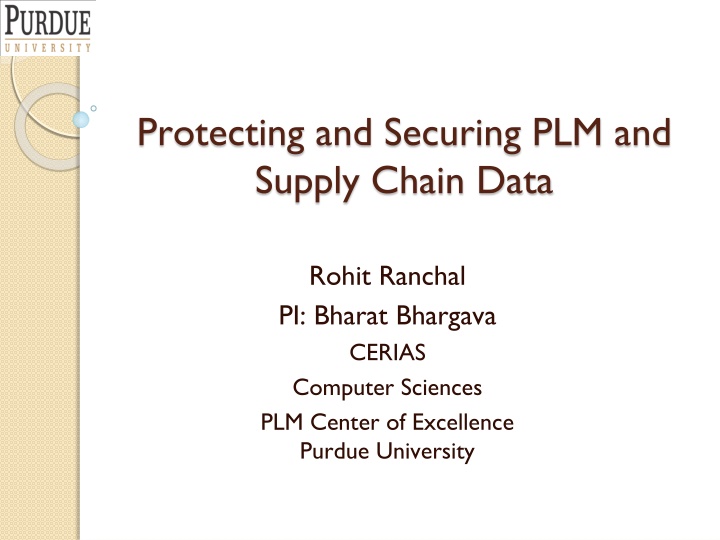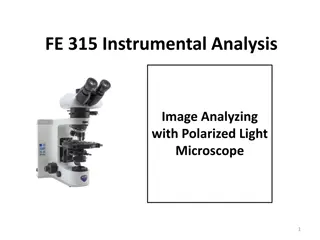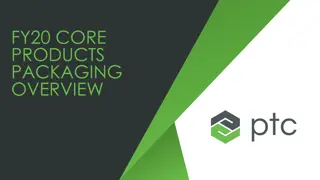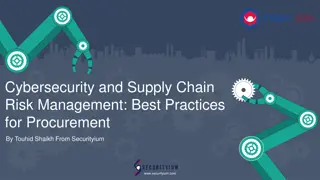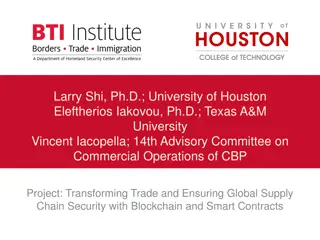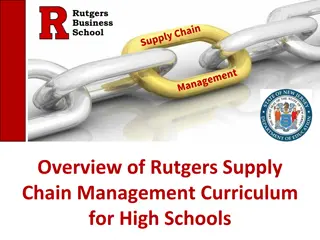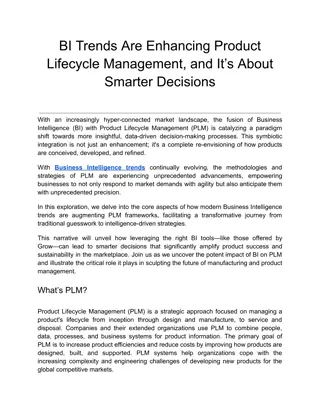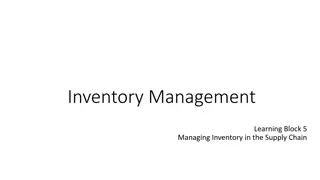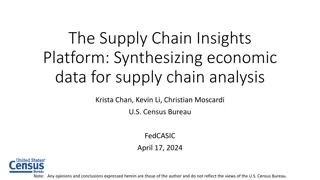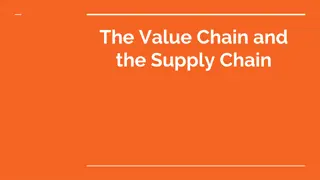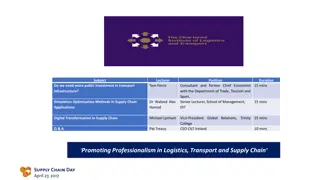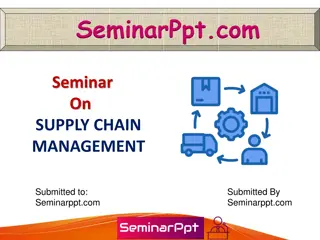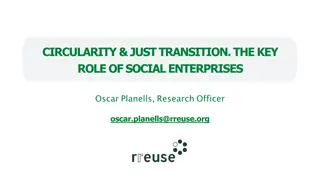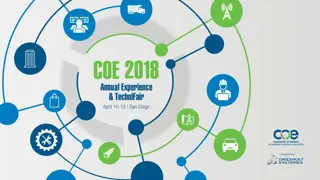Enhancing Security of PLM and Supply Chain Data in Modern Enterprises
Modern enterprises rely on globally distributed supply chains and PLM systems to manage sensitive information, posing security challenges due to outsourcing and information flow complexities. Security threats such as data leakage can lead to financial losses, reputational damage, and criminal activities with national security implications.
Download Presentation

Please find below an Image/Link to download the presentation.
The content on the website is provided AS IS for your information and personal use only. It may not be sold, licensed, or shared on other websites without obtaining consent from the author.If you encounter any issues during the download, it is possible that the publisher has removed the file from their server.
You are allowed to download the files provided on this website for personal or commercial use, subject to the condition that they are used lawfully. All files are the property of their respective owners.
The content on the website is provided AS IS for your information and personal use only. It may not be sold, licensed, or shared on other websites without obtaining consent from the author.
E N D
Presentation Transcript
Protecting and Securing PLM and Supply Chain Data Rohit Ranchal PI: Bharat Bhargava CERIAS Computer Sciences PLM Center of Excellence Purdue University
Outline Background Problem Statement Related Work Managed Information Object Active Bundle Scheme Extending Active Bundle Scheme Possible Projects 2
Background: Modern Enterprises Globally distributed operations e.g. Boeing, Cummins, Dow Agro Sciences Focus on core competencies and outsource auxiliary tasks to partner organizations Rely on Supply Chain to collaborate with partners in transforming raw materials into products Use PLM Information Systems to manage the information flow that facilitates the movement of physical product related entities in the supply chain PLM systems continuously receive, process and share dynamic supply chain information (sensitive data) Commercial information shared with advisors and lawyers Personally identifiable information about customers and employees Intellectual property shared with partners 3
Background: Supply Chain Interaction Information Flow in Supply Chain 4
Information Flow in Supply Chain Globally distributed supply chain processes Information not confined to a single domain but distributed among and controlled by multiple partners Outsourcing of shared information by partner organizations No way to track the information access and usage in external domain (organization has no control over the processes in external domain) Intermediate steps of information flow might expose information to hostile threats Unauthorized disclosure and data leakage of information shared among partners across multiple domains Violations and malicious activities in a trusted domain remain undetected 5
Impact of Security Threats Leakage of sensitive information - list of customers, product secrets etc to competitors, malicious entities, government institutions or attackers High financial losses Damage to the reputation of organization and its partners Criminal activities Affect on National Security 6
Challenges for Supply Chain Security Lack of mechanisms to communicate information owner s policies to the protection frameworks of the partners Lack of information sharing standards for protecting data in distributed supply chains Custom security requirements and controls applied by partners Incompatibility and reduced ability to ensure policy enforcement leaves security gaps Disparate, evolving and changing Information security standards to satisfy changing business models, regulatory and geographical law requirements 7
Related Work Generalized approach to protect shared data Secure data e.g. using encryption Define Policies for data sharing and usage e.g. access control policies Setup Policy enforcement mechanism to enforce policies on data Classification of available solutions Policy Enforcement at the Sender Policy Enforcement in the middle Policy Enforcement at the Receiver 8
Related Work Policy enforcement at owner Traditional approach uses encryption for protection (interactive protocols) e.g. Servers A lot of exchange of messages Source can become bottleneck Problem if source becomes unavailable Digibox [5] uses multiple keys 9
Related Work Policy enforcement in the middle Trusted Third Party e.g. pub/sub Single point of trust and failure Information aggregation - caches and stores data Can sell data to interested parties Data disclosure during Subpoenas Prone to hacking attacks and insider abuse Casassa Mont et al [9] uses time vault service 10
Related Work Policy enforcement at receiver Requires a Trusted component Eg Digital Rights Management solutions, Document-sharing solutions - Adobe, Microsoft etc Distribution issues of Trusted component Restricted to known/trusted hosts Montero et al [6] uses sticky policies 11
Proposed Approach Existing approaches that rely on the use of standards, service level agreements, and legal contracts are insufficient Propose an end-to-end approach for protecting shared data in digital supply chains Self-protecting data centric approach for policy based controlled data dissemination Security auditing of business processes that compose supply chains Enables tracking the information flows of shared data Detecting malicious interactions and compromised business processes of partners Tracks the data flow and actions upon them and enables auditing, detecting and reporting policy violations 12
Approach 1: Self-Protecting Data Active bundle (AB) [12, 13] Encapsulation mechanism for protecting data Includes metadata for controlled dissemination Includes Virtual Machine Policy enforcement mechanism Protection mechanism Active Bundle Operations Self-Integrity check Filtering Selective dissemination based on policies Apoptosis Self-destructs AB completely 13
AB based on TTP [13] AB information disclosure Active Bundle Destination User Application Active Bundle Active Bundle (AB) Active Bundle Creator Audit Services Agent (ASA) Security Services Agent (SSA) Directory Facilitator Trust Evaluation Agent (TEA) Active Bundle Coordinator Active Bundle Services 14
Enabling AB 15
AB Updates Supply Chain entities in the information flow receive AB and update its information Scenario 1: Send update request to owner Distributor Retailer Sensitive data Information addition Sensitive data 16
Problems with updating an AB Advantage Simple The owner can control every update Disadvantage The update request may be rejected or partially rejected by the owner The new privacy policy for the updated AB is created by the owner which may conflict with the updater s policy The updater may not want the original owner to know the appended data The owner may get a lot of requests for updates 17
AB Update Solution Nested Structure An active bundle autonomously grows into a bigger active bundle including both the original active bundle and the appended information with new metadata and virtual machine ??? ?,? ?,? Sensitive data ?,? Sensitive data Appended information ??? ??? ??? ??? ??? ??? 18
AB Update Solution Advantage Any entity with the permission to append information can append and specify the new privacy policy for the appended information Existing policies are still effective on the existing data and new policies are only enforced on the appended data and the existing data The nested structure of an active bundle naturally represents the history of updates Disadvantage AB s size grows linearly with every update The new policies may be more restrictive than the original policies which may restrict access to the original data Possible Solution: VMs of Nested ABs are redundant. A single common VM can serve all Nested ABs 19
Improving the AB Implementation Improve the AB implementation by making it less dependent on TTP Provide a mechanism for policy based selective dissemination Use a policy language to define policies Providing resilience against malicious hosts Application specific development and experimentation 20
Improving AB Implementation Provide selective dissemination Organize data in AB into separate items Encrypt each item with a different key Decrease dependence on TTP Use Shamir s threshold secret sharing technique [16] to split each of the decryption keys into N shares Set a threshold t such that t shares are required for key reconstruction Store the key shares in a distributed hash table (DHT) built on top of P2P system (Vuze) [26] Each share is stored at a random node 21
DHT scheme for AB AB Key distribution AB Key reconstruction 22
Advantages of using DHT Huge scale - millions of geographically distributed nodes Decentralized individually owned nodes with no single point of trust Load reduction and Asynchronous communication no synchronization issues Hard to deduce all the shares (atleast t) Hard to compromise all the nodes that store the shares Use periodic splitting to protect against dynamic adversaries 23
Improvement in DHT DHT loses key shares over time Nodes crash or leave Need to republish the shares for availability Use a hybrid DHT (combination of reliable* DHT and public DHT) [26] Split K into K and K Split K into n shares and store in reliable DHT Split K into n shares and store in public DHT 24
AB Policies Extend the AB approach with a formal language for specifying policies Need efficient policy negotiation mechanism OASIS eXtensible Access Control Markup Language (XACML) [17] Role Based Access Control (RBAC) [18] 25
Protection against Malicious Hosts Use TPM [7] to ensure that host is not already compromised Perform code obfuscation hide data and real program code within a scrambled code Intertwine code and data together hide data within the code to make it incomprehensible Use of polymorphic code [25] code changes itself each time it runs but its semantics don't change Can store the control flow information in random DHT nodes 26
Active Bundles Capabilities Capabilities Controlled and Selective Dissemination: Control the dissemination and selectively share the data based on the policies Quantifiable and Contextual Data Dissemination: Track the amount of data disclosed to a particular host and decide to further disclose or deny data requests Dynamic Metadata Adjustment: Update the policies based on a context, host, history of interactions, trust level etc. 27
Active Bundles Advantages Do not require hosts to have a policy enforcement engine or a trusted component Doesn t rely on a dedicated TTP No trusted destination host assumption works on unknown hosts Decentralized Distributed Asynchronous communication 28
Approach 2: End to End Auditing Trust Broker Trusted third party responsible for maintaining end-to- end auditing in information flow chain Maintains a list of certified business processes that use the Taint Analysis Module and ensure their compliance with the required security controls Manages end-to-end client/process-invocation session Taint Analysis Low level layer that monitors the interactions of business processes (at runtime) Inspects the data exchanges (information flow) and reports policy violations 29
Trust Broker Certifies business processes upon certification by an external trusted authority Certification assures that the business process allows tracking of information flow and ensures secure messaging Maintains an end-to-end session of business processes interactions Collects and audits the activities of the business processes of the collaborating partners Logs warnings of illegal interactions and informs the client process about the detected violation 30
Taint Analysis Independent of processes No need to change the processes or access the source code of processes Interception of process execution (Process remains transparent) Uses program instrumentation to gain control upon the occurrence of certain events Two possible deployment options Only in Trusted Domains Detection of insider attacks Detection of compromised processes Detection of outbound interactions In Public Domains Enforcing service composition policies 31
Secure Supply Chain Interaction using the Approach 32
Information Flow using the Approach Client Business Process decides sharing information with a Trusted Business Process A and requests a session in the Trust Broker (TB) to keep track of this interaction s activities for end-to-end information flow Client Business Process shares information with Trusted Business Process A Trusted Business Process A uses this information and shares it with Trusted Business Process B. During this exchange, the Taint Analysis (TA) module intercepts the communications and reports any illegal external interaction to the TB Trusted Business Process B shares data with (possibly untrusted) Public Business Process C. TA detects the interaction and reports the activity to TB TB informs the Client Business Process about the activity of Trusted Business process B 1. 2. 3. 4. 5. 33
Capabilities of the Approach Controlled information sharing Information flow tracking Monitoring information usage and detecting illegal sharing No interference between the security mechanisms and supply chain operations Scalable and reliable to be used for large supply chains Reporting unauthorized information usage and disclosure by entities while in transit between the partners 34
References R. Shirey, Internet Security Glossary, Version 2, The Internet Engineering Task Force (IETF), RFC4949, August 2007. Online at http://tools.ietf.org/html/rfc4949 iPad Mini Heist: $1.5 Million Stash Of Apple Devices Reportedly Stolen From JFK Airport, Nov. 2012, online at: http://www.huffingtonpost.com/2012/11/15/ipad-mini-heist-million- stolen-jfk-airport_n_2137799.html Hackers attack Foxconn for the laughs, Feb. 2012, online at: http://www.macworld.com/article/1165298/foxconn_reportedly_hacked _by_group_critical_of_working_conditions.html H. Livingston, T. Telesco, L. Gardner, R. Loeslein, E. Zelinski, and W. Pumford, Counterfeit Parts Safeguards and Reporting U.S. Government and Industry Collaboration to Combat the Threat, Defense Standardization Journal, pp.9-16, Jan/Mar 2010. Verizon 2012 Data Breach Investigations Report, http://www.verizonbusiness.com/resources/reports/rp_data-breach- investigations-report- 2012_en_xg.pdf?CMP=DMC- SMB_Z_ZZ_ZZ_Z_TV_N_Z037 World Economic Forum, New Models for Addressing Supply Chain and Transport Risk, 2011. Insider Threat Center at Cert, Examining Insider Threat Risk at the US Citizenship and Immigration Services, Dec. 2010, online at: http://www.dhs.gov/xoig/assets/mgmtrpts/OIG_11-33_Jan11.pdf N. Browne, M. de Crespigny, J. Reavis, K. Roemer, and R. Samani, Business Assurance for the 21st Century: Navigating the Information Assurance landscape, white paper, Information Security Forum, 2011. 1. 2. 3. 4. 5. 6. 7. 8. 35
References B. Fabian, and O. Gu nther, Security Challenges of the EPCglobal Network, Communications of the ACM, v.52 n.7, July 2009. 9. 10. M. Swanson, N. Bartol, and R. Moorthy, Piloting Supply Chain Risk Management Practices for Federal Information Systems, Draft NISTIR 7622. NIST, 2010. 11. M. Atallah, H. Elmongui, V. Deshpande, and L. Schwarz, "Secure supply-chain protocols," in IEEE International Conference on E- Commerce, pp. 293-302, 2003. 12. R. Ranchal, and B. Bhargava, Protecting PLM data throughout their lifecycle, in 9th International Conference on Heterogeneous Networking for Quality, Reliability, Security and Robustness (Qshine), 2013. 13. M. Azarmi, B. Bhargava, P. Angin, R. Ranchal, N. Ahmed, A. Sinclair, M. Linderman, and L. ben Othmane, An End-to-End Security Auditing Approach for Service Oriented Architecture, In 31st IEEE Symposium on Reliable Distributed Systems (SRDS), 2012. 14. G. Kiczales, J. Lamping, A. Mendhekar, C. Maeda, C. Lopes, J. Loingtier, and J. Irwin, Aspect- oriented programming, European Conference on Object-Oriented Programming (ECOOP 97), pp. 220 242, 1997. 15. L. Othmane, and L. Lilien, Protecting Privacy in Sensitive Data Dissemination with Active Bundles, In The 7th Annual Conference on Privacy, Security and Trust, Saint John, NB, Canada, 2009. 16. L. ben Othmane, Active bundles for protecting confidentiality of sensitive data throughout their lifecycle, Theses, Western Michigan University Kalamazoo, MI, USA, December 2010. 36
